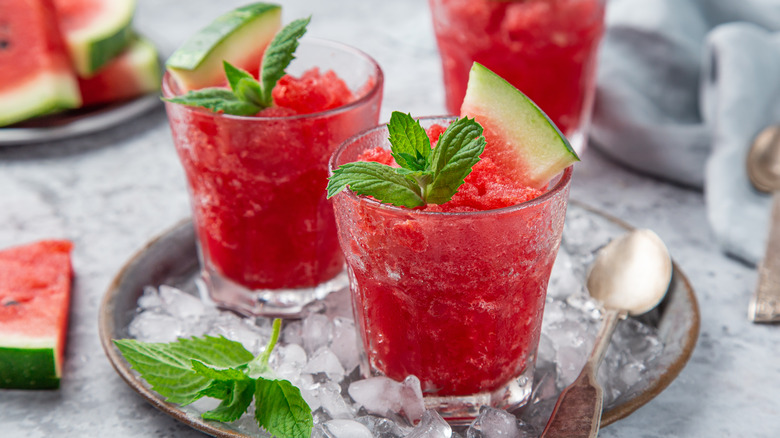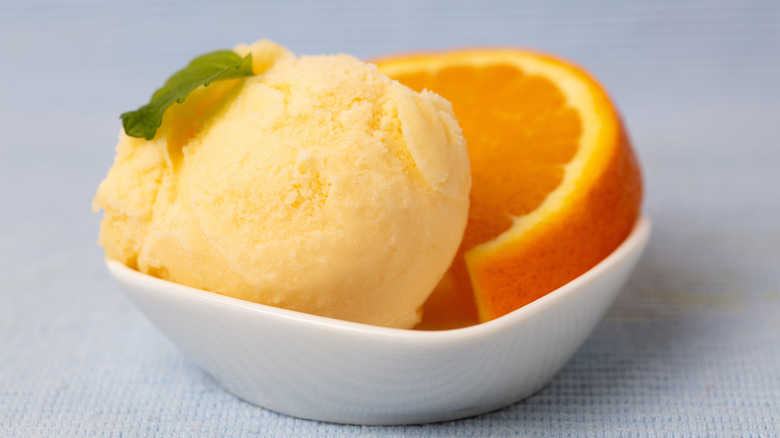The Technique That Makes Granita Different From Sorbet
Sorbet and granita are two classic iced desserts with ties to Italy, both known for their refreshing mouthfeel and taste. Their origins are admittedly hazy, but supposedly, it was Arabian sugarcane traders on the Silk Road who first introduced thirsty Sicilians to the idea of "sharbat" (related to the word sherbet), a blend of snow and fruit juice (via Life in Italy). According to Mediterranealicious, this gave Sicilians the bright idea of mixing snow from Mount Etna with lemon juice for a light refreshment — now that's a next-level commitment to dessert.
However, iced desserts as we know them didn't really rise to prominence until the 1500s, when they became a favorite treat at the Medici court as a result of fruit sherbert being served at queen regent Catherine de' Medici's wedding (via The Florentine and She Legends). As outlined by Fine Dining Lovers, Sicilians were also busy with their own innovations in that same era, creating the "pozzetto" — a zinc bucket contraption that froze sugared juices and churned them with blades to create a refreshing dessert.
As the centuries passed, what started as the humble Arabian snow cone split into three key types of Italian iced dessert we're most familiar with — gelato, sorbet, and granita. However, there may be confusion between the latter two considering neither uses dairy, and they both have an icier, airier appearance than gelato. What exactly makes them different from each other? Let's start with sorbet.
Sorbet is churned, making it solid and smooth
Essentially, sorbet is an iced dessert that contains no dairy — otherwise, it would be creamier like sherbet. Without the dairy, this makes it less dense and easier to melt in your mouth than Italian gelato. Since sorbet's consistency is lighter than your typical ice cream, it complements tart and citrus flavors. However, Real Simple shares that they are usually made from fruit and sugar via the same churning process used for ice cream. This results in a solid consistency, making them easy to scoop into cones.
Sorbet is versatile and has a sophisticated identity beyond that tasty treat you slurped on the beach. MasterClass notes it can also be served as a between-course palate cleanser known as the "intermezzo." By presenting a sorbet with a bright or sharp taste like lemon, lime, or mint, you can offer guests a welcome flavor shift after, say, a salty fish course or fatty meats.
Granita is scraped, making it flaky and light
Just like with sorbet, you can enjoy granita as a cooling snack, dessert, or palate cleanser. As Gambero Rosso states, this refreshing treat is probably the most closely related to the original Arabian sherbet. Essentially, it is an iced purée of fruit, sugar, and water, although it can be made with non-fruit ingredients too. However, unlike sorbet, there is no churning process, meaning it's less smooth. Instead, the ice is scraped bit by bit while freezing so that you end up with a flaky structure that's lighter and more crystalline than sorbet — think snow cone or slushy.
For this reason, you can't scoop granita into cones as it won't hold up — instead, it's served in dessert glasses with a straw or spoon, depending on the consistency, according to Curious Cuisiniere. The texture of granita is also a regional thing in Sicily, with the ice usually being smoother on the East coast and coarser on the West coast.
Popular flavors include lemon, almond, pistachio, mulberry, and mint, plus you can get local Sicilian variations like chocolate in Catania and coffee in Messina (via Cooks Info). Unlike sorbet, Italy Segreta shares that granita can also be served as a summer breakfast dish accompanied by "brioche col tuppo" (brioche with a topknot) and topped with whipped cream.
So if you'd like to enjoy a dessert that has a thicker churned consistency, go for a scoop of sorbet. But if you desire a lighter and flakier taste, granita is your next best bet.


